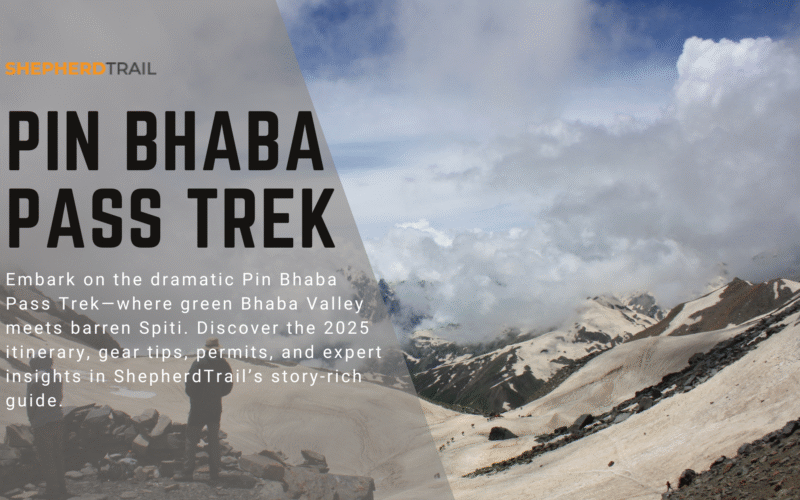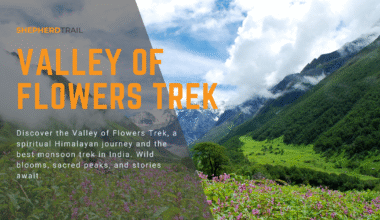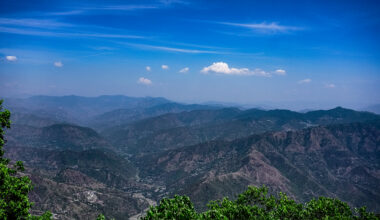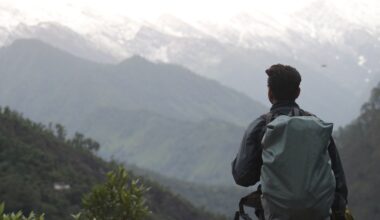Pin Bhaba Pass Trek – Where Lush Forests Meet Barren Dreams
By ShepherdTrail – Where Every Trail Tells a Story
📅 Updated: June 2025
📍 Region: Himachal Pradesh
🧭 Trek Duration: 8–9 Days
🌄 Altitude: 16,100 ft (4,910 m)
🎒 Difficulty: Moderate to Difficult
🌿 Two Worlds, One Trail – The Magic of Pin Bhaba
There are treks that test your endurance, some that offer spiritual stillness, and then there’s Pin Bhaba Pass—a trail that stitches together two entirely different worlds.
On one side, the Bhaba Valley in Kinnaur is lush, green, brimming with life and alpine beauty. On the other, the Pin Valley in Spiti is stark, barren, dramatic, and painted in brown and crimson hues. Walking through this pass feels like crossing into another planet, almost like time travel—from abundance into stillness.
This is the soul of the Pin Bhaba Pass trek—a journey not just over terrain, but across contrasts, cultures, and centuries of Himalayan stories.
🗺️ Trek Overview
| Feature | Detail |
|---|---|
| Starting Point | Kafnu (2,400 m) |
| Ending Point | Mudh Village, Pin Valley |
| Best Time to Trek | Mid-June to Mid-September |
| Highest Point | Pin Bhaba Pass (4,910 m / 16,100 ft) |
| Trek Type | Crossover (Kinnaur to Spiti) |
| Trail Length | ~50 km |
| Permit Required | Yes (Inner Line Permits for Spiti) |
🧭 Day-by-Day Itinerary
🚌 Day 1: Shimla to Kafnu (2,400 m)
-
Distance: 210 km
-
Time: 7–8 hrs
The drive from Shimla to Kafnu is scenic and gives your first taste of Kinnaur’s deep-cut gorges and apple-laden slopes. Kafnu is a quiet village nestled at the base of the Bhaba Valley. This will be your acclimatisation stop before the trek begins.
🌿 ShepherdTrail Note: Try the local Kinnauri apples and apricots. Their sweetness is matched only by the people here.
🥾 Day 2: Kafnu to Mulling (3,250 m)
-
Trek: ~11 km
-
Time: 6–7 hrs
The trail begins with a thrilling section through pine forests and riverside walkways. You’ll pass through dense coniferous canopies, wooden bridges, and thundering streams. The Mulling campsite, surrounded by cliffs and a bubbling stream, offers one of the most scenic overnight halts of the trek.
🌿 Trail Wisdom: This is where you’ll start feeling the altitude—hydrate and pace yourself well.
🥾 Day 3: Mulling to Kara (3,550 m)
-
Trek: ~6 km
-
Time: 4–5 hrs
Short and rewarding, today’s trail cuts through rolling meadows and glacial streams. Expect wildflowers carpeting the grass and horses grazing freely. Kara is a beautiful campsite, often dotted with shepherd tents in season.
🌿 Trail Wisdom: Keep your camera ready—sunrise here paints the entire valley gold.
🥾 Day 4: Kara to Pushtirang (4,100 m)
-
Trek: ~5 km
-
Time: 4 hrs
As you climb higher, vegetation thins and terrain becomes rocky. The temperature drops here, and altitude gain is significant. Pushtirang lies just below the pass, surrounded by rugged cliffs and prayer-flag-studded ridges.
🌿 Acclimatization Tip: A short acclimatization walk in the evening can make your pass-crossing day smoother.
🏔️ Day 5: Pushtirang to Pin Bhaba Pass (4,910 m) to Mangrungse (4,100 m)
-
Trek: ~12 km
-
Time: 9–10 hrs
The summit day—challenging, long, and incredibly rewarding. The trail ascends over scree, boulders, and snowfields to the pass. At the top, you’re met with a 360-degree panorama of Bhaba Valley’s green slopes on one side and Spiti’s barren grandeur on the other.
The descent into Spiti is steep, dramatic, and often snow-clad even in late summer. Mangrungse campsite feels like a page out of a Martian landscape—crimson rocks and no trees in sight.
🌿 Spiritual Parallel: It’s like shedding one life and stepping into another.
🥾 Day 6: Mangrungse to Mudh Village (3,750 m)
-
Trek: ~13 km
-
Time: 6–7 hrs
The final stretch of the trail leads you into Pin Valley National Park—a region known for snow leopards, blue sheep, and stark beauty. Mudh, your final stop, is a picturesque hamlet with pink barley fields and whitewashed mud homes.
🌿 Trail Tradition: End your trek with a cup of butter tea and a conversation with the locals. They have stories that don’t make it into maps.
🧭 Why Pin Bhaba Is Special
1. Dual Personality Trail
Start in forests, end in deserts. The Bhaba side is green and alive, while the Spiti side is dry and dramatic. Very few trails in India offer this sudden shift.
2. Passage of Cultures
You don’t just cross a pass; you cross from Hindu villages of Kinnaur into the Buddhist belt of Spiti. Expect temple bells on one end, and prayer flags on the other.
3. Relatively Less Crowded
While treks like Hampta Pass draw huge numbers, Pin Bhaba remains a quieter affair. Perfect for those who seek solitude with scenery.
4. Spiritual Echoes
The Pin Valley is sacred in Tibetan Buddhism. Monks from nearby Kungri Monastery often walk the same trails. There’s an aura of prayer on wind here.
🧘 Spiritual & Cultural Layers
Pin Bhaba isn’t just about terrain—it’s about transformation. The trail connects Kinnaur’s Hindu-Buddhist influences with Spiti’s stark Tibetan spirituality. You’ll spot mane walls, chortens, and flags fluttering in the wind—each a silent prayer etched into the landscape.
Even the pass-crossing holds symbolic weight. In old times, shepherds and monks would walk this trail as a form of seasonal pilgrimage or trade, carrying salt and barley across the ridge.
🧳 Essential Trekking Gear
The Pin Bhaba Pass Trek throws both lush forest and barren cold desert at you. So pack smartly:
-
Trekking poles (crucial on descents)
-
Layered clothing for rapid weather changes
-
Sturdy, broken-in trekking shoes
-
Waterproof gloves and shell jacket
-
High-altitude sleeping bag
-
Sunglasses + Sunscreen (UV is harsh in Spiti)
-
Power banks + downloaded offline maps
🌿 Gear Tip: Check out our “Gear We Use” series for detailed reviews on essentials like sleeping bags, tents, hiking poles, and more.
🧾 Permits & Registration
Since the trek crosses into Spiti, an Inner Line Permit is required for foreign nationals. Indian citizens usually do not need a permit, but it’s best to check with local authorities or your trek operator before you begin.
🌿 Documentation Tip: Carry multiple photocopies of ID proofs (Aadhar/Passport) and a few passport-size photos.
📅 Best Time to Trek
Mid-June to mid-September is the ideal window.
-
✅ June: Snowfields still linger—great for snow lovers.
-
✅ July–August: Meadows bloom, rivers swell. Monsoon affects Kinnaur side, but Spiti stays dry.
-
✅ September: Crisp views and clear skies. Cold sets in after mid-September.
Avoid early June and post-October due to snow blockage and extreme weather.
🚌 How to Reach Kafnu
-
Nearest Railhead: Shimla or Kalka
-
Nearest Airport: Chandigarh (IXC)
-
From Shimla: Take a taxi or shared jeep to Rampur → Wangtu → Kafnu
🌿 Travel Tip: If you have time, spend a day in Sangla or Kalpa to acclimatize and soak in Kinnauri culture.
🛏️ Stay Options
-
Kafnu: Basic guesthouses, homestays
-
Mudh: Guesthouses with limited but warm hospitality
-
En route: Camping
💬 Final Thoughts: A Trail That Changes You
Pin Bhaba isn’t for ticking off a list. It’s for those who want to feel the pulse of two valleys with every step. It’s for those who believe that contrast is not conflict—but beauty in transition.
When you step into Spiti after days of Bhaba’s greenery, you’ll realize this wasn’t just a trek—it was a story of opposites, told in footnotes of wildflowers and wind.
📞 Ready to Trek with Us?
ShepherdTrail now offers customised Pin Bhaba Pass Trek packages for small groups and solo trekkers with certified guides, porter services, and all logistics taken care of.
📞 Call or WhatsApp us: 7340973455
🌐 Visit: www.shepherdtrail.in
📸 Instagram: @ShepherdTrail
Trek can also be booked using the link below.







